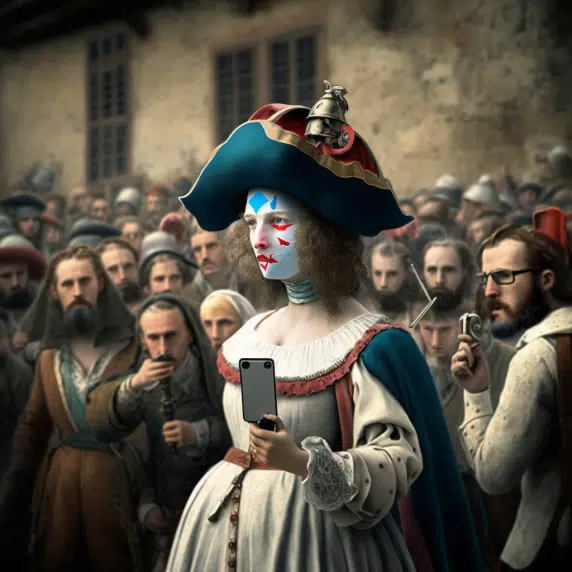XR + AI: 5 tools driving today’s content revolution
These five tools at the intersection of extended reality and artificial intelligence are driving a content revolution with endless possibilities.
Generative AI is taking our industry by storm, and every marketer out there needs to pay close attention. The technology solves one of our major challenges — creating tons of unique and compelling content. Our always-on, digital world has forced us to become publishers of hyper-relevant content to connect with and reach our audiences.
The advent of Web3, the metaverse and other immersive technologies arms us with powerful tools to build an emotional connection with audiences all over the globe. Building 3D content to fill entire worlds used to be expensive and daunting, a blocker for mass adoption by marketing teams. But that’s no longer the case.
AI tools have matured so anyone can create amazing, mind-blowing and unique content. The list of AI content creation tools and use cases across our industry is massive, so I’m focusing on where my passion lies — at the intersection of XR and AI.
This unbelievable power couple of AI tools like Midjourney and the latest immersive and 3D worlds fuel nothing short of a content revolution. Soon, anyone with the vocabulary to describe an environment or person can produce it in hyper-realistic 3D. No coding is required, just specific, artistic and carefully engineered language. (Finally, a good use for that art history degree!)
Below I have outlined five specific use cases for this happy marriage.
1. Exclusible: Using generative AI to speed up the development of XR projects
Exclusible positions themselves as your “Web3 one-stop shop,” offering services such as:
- Building immersive spaces.
- Creating digital collectibles and NFTs.
- Launching dedicated marketing campaigns to reach the Gen-Z audience.
They have launched an NFT plug-and-play platform called Highloop which allows marketers to easily create branded collectibles that don’t require coding skills or a cryptocurrency wallet.
Exclusible helps brands like Hugo Boss, Christian Lacroix and Alpine build experiences using XR and Web3 technology. Founder Olivier Moingeon strongly advises brands not to sell NFTs and instead to consider this emerging technology as a long-term strategy to win the hearts of future customers.
Moingeon has a long history with luxury brands and is helping them build relevance with a younger demographic. He believes the future of fashion is digital and that fashion houses will be selling digital wearables as their bread and butter within the next few years. Fashion retail brand Zara is already creating digital wearables inspired by their real-world items.

A great example of Exclusible’s work is the recently launched Spatial.io experience for Hugo Boss, which includes a quest. When completed, the user is awarded a limited-edition NFT from the brand’s spring collection, which can be worn on their avatar.
The beautifully rendered 3D experience was built in weeks with the help of AI. The Exclusible team worked with Hugo Boss to create mood boards and initial project designs using generative imaging tools, shaving off months of work.
2. Roblox: Using AI to democratize 3D content creation
I’ve been singing the praises of Roblox for months now. They are founded on the fundamental principles I outline in my Metaverse Manifesto, creating digital spaces that provide users the tools to create the world around them easily.
Roblox is now building its own generative AI tools to help their community easily bring their visions to life on the 3D platform, according to a recent AdAge report. This indicates that Roblox is playing the long game and valuing their audience above quick wins for investors.
Building their own AI tools won’t be easy or cheap. However, it will hopefully provide a seamless and integrated way to use tools like Midjourney and ChatGPT to create Roblox content. Many 3D building engines have generative AI apps and integrations with varying levels of success. If Roblox nails this, they will give their community the power to build anything imaginable with a few clicks and clever prompts.
You might be thinking — so what? Why do I care about Roblox, which is mostly a gaming platform for tweens. Well, it’s more than a gaming platform. With over 200 million active users, many of which engage with brands, Roblox has significant potential.
Brand engagement is among the use cases for the metaverse with the most potential, per a McKinsey study. The same report estimates that by 2030, the metaverse could generate $4 trillion to $5 trillion across consumer and enterprise use cases.

Nike, Vans, Chipotle and Hot Topic are just a few brands finding success on Roblox. Nikeland on Roblox has hosted over 26 million visitors and sold over $185 million of NFTs for digital footwear and apparel, McKinsey reports. How about that for your ROI of immersive tech?
I realize not every brand is Nike, but you need an immersive technology and Web3 strategy, even if that involves waiting and seeing how this experiment unfolds.
3. Spatial.io: Bringing the power of generative AI and XR to the masses
I might call Spatial.io the Roblox for adults, as 75% of the platform’s 1 million active users are over 24 years old, according to a recent report. They are doing a great job of building an accessible and intuitive 3D world that can be consumed on a PC, tablet, smartphone or VR headset. This cross-device accessibility and their partnerships with big brands like Hugo Boss and Benefit cosmetics are helping to get the word out.
Spatial.io has what other platforms are lacking — fun, interactive spaces that house other users and integrations with companies like Ready Player Me that help to remove onboarding friction. At any given time, you can log in to Spatial.io and have a plethora of populated worlds to visit. Whether you visit the Boss Immersive Showroom or the Buddhaverse, there’s something for everyone.

Spatial.io also makes it easy to create immersive spaces and has a robust creator toolkit that doesn’t require coding. I was able to create a 3D home space in a matter of minutes, and I can also build quests, custom avatars, moving vehicles and other forms of gamification.
Spatial.io is building tools for its citizens while providing value to brands by working closely with them to provide data analytics, key integrations and strategic guidance for successful activations.
4. Ready Player Me: Integrated AI tools for speedy personalization
Avatars — and avatar creation — are among the biggest friction points for online immersive spaces. Because these digital versions of ourselves tap into our identity and expression in the world, they can become a focal point for any experience. One key misstep brands make is underestimating the importance of the avatar selection and creation process within 3D experiences.
Providing users with many options and making it easy and intuitive to customize their avatar is a huge deal. Often, a key frustration for users is the inability to take their custom avatar with them to different virtual spaces. Ready Player Me is trying to solve that problem with their universal avatar technology. Spatial.io and other platforms have paired up with Ready Player Me to allow users to bring their customized avatars into each unique platform.
As with any new integration, there are bugs to work out. However, this is getting us one step closer to a true, interoperable metaverse that allows users to freely travel between worlds using the same language, currency and, of course, the same digital body or avatar.
Ready Player Me has over 7,500 partners supporting their universal avatar technology. That’s a lot of different virtual spaces, and crafting a unique avatar for each one would be a major headache.

Ready Player Me allows users to start with a pre-made avatar template or upload a photo of their face. The photo upload feature is creepy and not something I would want to use until the technology improves. I’m more of a fan of creating an avatar inspired by the real me, using these amazing tools to help find new ways of self-expression and empowerment.
5. Midjourney: AI ‘text to image’ creation platform constructs artwork in seconds
Midjourney is every creative agency’s dirty little secret that’s not so secret anymore. Every creative team I’ve talked to over the last month has admitted to using this image creation tool.
Whether it’s being used to help ideate during the design phase or create compelling presentations and social content, agencies are all over it. Anyone responsible for creating visual content can benefit from this tool, and it’s easy to use and somewhat addictive.

You simply provide prompts or a string of words that describes the image you want to create, and the tool does the rest of the work for you. The more detailed and advanced your prompts are, the more incredible the resulting images, which has created the skill of “prompt engineering.”
Using the right prompts for AI-driven tools is one of the key skills we all need to learn to survive this AI takeover, according to PJ Pereira. The novelist and founder of award-winning agency Pereira O’Dell shared his vision on thinking about AI, along with a hands-on tutorial on crafting prompts for Midjourney in a recent XR Pub Crawl.
Contributing authors are invited to create content for MarTech and are chosen for their expertise and contribution to the martech community. Our contributors work under the oversight of the editorial staff and contributions are checked for quality and relevance to our readers. The opinions they express are their own.
Related stories
New on MarTech